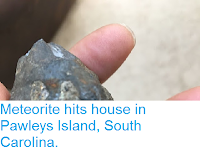Asteroid 2017 RV1 passed by the Earth at a distance of about 6 820 000
km (17.7 times the average distance between the Earth and the Moon, or
4.58% of the distance between the Earth and the Sun), slightly before 4.45 am
GMT on Thursday 12 October 2017. There was no danger of
the asteroid hitting us, though were it to do so it would have
presented a significant threat. 2017 RV1 has an estimated
equivalent
diameter of 180-570 m (i.e. it is estimated that a spherical object
with
the same volume would be 180-570 m in diameter), and an object of this
size would be predicted to be capable of
passing through the Earth's
atmosphere relatively intact, impacting the ground directly with an
explosion that would be 12 000-600 000 times as powerful as the
Hiroshima
bomb. Such an impact would result in an impact crater over 2-8 km
in
diameter
and devastation on a global scale, as well as climatic effects that
would last decades or even centuries.
The calculated orbit of 2017 RV1. Minor Planet Center.
2017 RV1 was discovered on 12 September 2017 (thirty days before its closest approach to the Earth) by the University of Hawaii's PANSTARRS
telescope on Mount Haleakala on Maui. The designation 2017 RV1 implies
that it was the 46th asteroid (asteroid V1) discovered in the first
half of September 2017 (period 2017 R).
2017 RV1 has a 1377 day orbital period and an eccentric orbit
tilted at an angle of 2.04° to the plane of the Solar System, which
takes it from 0.89 AU from the Sun (i.e. 89% of he average distance at
which the Earth orbits the Sun)
to 3.94 AU from the Sun (i.e. 394% of
the
average distance at which the Earth orbits the Sun, considerably more
than
twice the distance at which the planet Mars orbits the Sun).
It is therefore classed as an
Apollo Group Asteroid (an asteroid that is on average further from the
Sun than the Earth, but which does get closer). This means that the
asteroid has occasional close encounters with the planet Earth, with the last thought to have occurred in September 2002
next predicted to occur in September 2036. It is also calculated to have occasional close encounters with the planet Jupiter, with the last thought to have happened in October 1970 and the next predicted for February 2031. As
an asteroid probably larger than 150 m in diameter that occasionally
comes within 0.05 AU of the Earth, 2017 SN2 is also
classified as a Potentially Hazardous Asteroid (it comes no closer to
the Sun than 105% of the average distance at which the Earth orbit's the
Sun, but the Earth's orbit is not completely circular).
See also...
Follow Sciency Thoughts on
Facebook.







